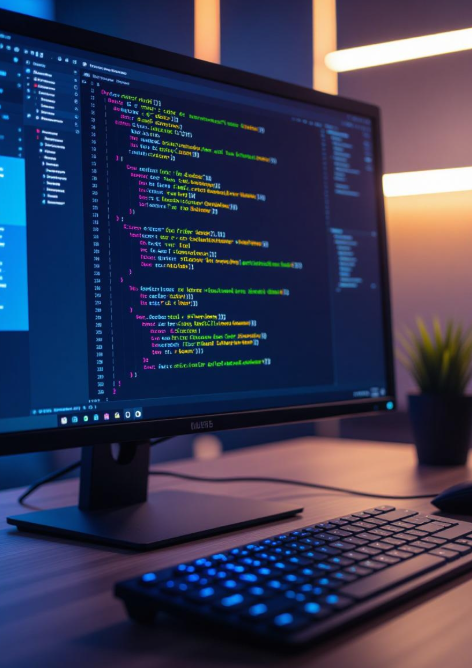Introduction
Imagine teaching a computer to recognize cats in photos the same way a child learns—by showing them thousands of examples until they understand what makes a cat a cat. This is the essence of neural networks and deep learning, technologies that have revolutionized everything from smartphone cameras to medical diagnosis.
In this guide, we’ll break down these complex concepts into digestible pieces that anyone can understand, no PhD required.
What is a Neural Network?
The Brain Connection
A neural network is a computer system inspired by the human brain. Just as our brains contain billions of interconnected neurons that work together to process information, artificial neural networks consist of interconnected nodes (artificial neurons) that collaborate to solve problems.
But here’s the key difference: while our brains are incredibly complex biological organs, artificial neural networks are mathematical models running on computers. They don’t “think” the way we do—they perform calculations.
The Basic Structure
Think of a neural network as a series of filters, each one refining information as it passes through:
1. Input Layer
- This is where data enters the system
- For image recognition, each pixel might be an input
- For text analysis, words or characters serve as inputs
2. Hidden Layers
- These are the “thinking” layers between input and output
- They detect patterns and features in the data
- A network might have one hidden layer or dozens (that’s where “deep” comes in)
3. Output Layer
- This produces the final answer
- For cat recognition: “Yes, this is a cat” or “No, it’s not”
- For translation: the translated sentence
A Simple Example
Let’s say you want to predict if someone will buy a product based on their age and income:
- Input: Age = 35, Income = $60,000
- Hidden layer: The network learns patterns like “people aged 30-40 with income $50K-$70K often buy”
- Output: 85% probability they’ll buy
The network learns these patterns by analyzing thousands of previous customers.
How Do Neural Networks Learn?
The Learning Process
Neural networks learn through a process called training, which works like this:
Step 1: Make a Guess The network starts with random settings and makes predictions (usually terrible ones at first).
Step 2: Measure the Mistake Compare the prediction to the correct answer. How wrong was it?
Step 3: Adjust Tweak the internal settings to reduce the error. This happens through a mathematical process called “backpropagation.”
Step 4: Repeat Do this thousands or millions of times with different examples until the network gets good at its task.
The Restaurant Analogy
Imagine learning to make the perfect pizza:
- First attempt: Too much salt (mistake identified)
- Adjustment: Use less salt next time
- Second attempt: Not enough cheese (new mistake)
- Adjustment: Add more cheese
- After hundreds of attempts: You’ve learned the perfect recipe
Neural networks do the same thing, but with mathematical weights instead of ingredients.
What is Deep Learning?
Going Deeper
Deep learning simply means using neural networks with many hidden layers—typically more than three. The “deep” refers to the depth of these layers, not the complexity of the concept itself.
Why More Layers Matter
Each layer learns progressively more complex features:
Layer 1: Detects simple edges and lines Layer 2: Combines edges into shapes Layer 3: Recognizes parts (like eyes, ears, whiskers) Layer 4: Identifies whole objects (a cat!)
This hierarchical learning mirrors how our own visual system works—we don’t see a cat all at once; our brain processes it from simple features to complex recognition.
The Breakthrough
Deep learning exploded in popularity around 2012 because three things came together:
- More data: The internet provided massive datasets
- More power: GPUs (graphics cards) could perform calculations much faster
- Better algorithms: Researchers developed techniques to train deeper networks
Real-World Applications
Computer Vision
Facial Recognition: Your phone unlocking when it sees your face
- The network learns unique facial features
- Works even with different angles and lighting
Medical Imaging: Detecting tumors in X-rays
- Networks trained on thousands of medical images
- Often match or exceed human radiologist accuracy
Self-Driving Cars: Identifying pedestrians, traffic signs, and obstacles
- Multiple neural networks work together
- Process camera, radar, and sensor data simultaneously
Natural Language Processing
Translation: Google Translate converting between languages
- Networks learn relationships between words in different languages
- Context-aware translations, not just word-by-word
Chatbots and Assistants: Siri, Alexa, ChatGPT
- Understanding spoken or written queries
- Generating human-like responses
Sentiment Analysis: Understanding emotions in text
- Companies analyze customer reviews
- Social media monitoring for brand perception
Other Applications
Recommendation Systems: Netflix suggesting shows, Amazon recommending products Speech Recognition: Converting spoken words to text Game Playing: AlphaGo defeating world champions at Go Drug Discovery: Predicting how molecules will interact Weather Forecasting: Analyzing complex atmospheric patterns
Types of Neural Networks
Feedforward Networks
- Simplest type
- Information flows in one direction: input → hidden → output
- Good for basic classification tasks
Convolutional Neural Networks (CNNs)
- Specialized for image processing
- Use “filters” that scan across images
- Power most computer vision applications
Recurrent Neural Networks (RNNs)
- Have memory of previous inputs
- Excellent for sequences: text, speech, time series
- Used in language translation and speech recognition
Transformers
- The newest architecture powering modern AI
- Process entire sequences at once
- Behind ChatGPT, BERT, and other language models
Common Misconceptions
“Neural Networks Think Like Humans”
Reality: They perform mathematical operations. There’s no consciousness or understanding—just pattern matching at scale.
“They Always Need Huge Datasets”
Reality: While many need lots of data, techniques like transfer learning allow networks to learn from smaller datasets by building on pre-trained models.
“They’re Always Right”
Reality: Neural networks can be wrong, biased, or fooled. They learn from data, so if the data is flawed, the network will be too.
“Deep Learning Solves Everything”
Reality: Traditional algorithms are sometimes better, faster, and more interpretable. Deep learning isn’t always the answer.
Challenges and Limitations
The Black Box Problem
Neural networks are difficult to interpret. We can see inputs and outputs, but understanding why a network made a specific decision is challenging. This is problematic in healthcare or legal applications where explanations matter.
Data Hunger
Most deep learning models require enormous amounts of labeled data—thousands or millions of examples. Creating these datasets is expensive and time-consuming.
Computational Cost
Training large neural networks requires significant computing power, consuming substantial energy and resources. This raises environmental and accessibility concerns.
Bias and Fairness
Networks learn from data created by humans, which contains our biases. Facial recognition systems have shown racial bias, hiring algorithms have shown gender bias—all learned from biased training data.
Adversarial Attacks
Neural networks can be fooled by carefully crafted inputs. A few pixel changes might make a network see a panda as a gibbon, or a stop sign as a speed limit sign.
The Future of Neural Networks
Emerging Trends
Efficient AI: Creating smaller networks that work on phones and edge devices Explainable AI: Making neural networks more interpretable Few-Shot Learning: Teaching networks to learn from just a few examples Multimodal Learning: Networks that understand images, text, and sound together Neuromorphic Computing: Hardware designed to work like neural networks
What’s Next?
The field is moving toward:
- More energy-efficient models
- Better generalization (learning concepts, not just memorizing)
- Combining symbolic reasoning with neural learning
- More robust and reliable systems
- Addressing ethical concerns and bias
Getting Started: Resources for Learning
For Absolute Beginners
- 3Blue1Brown (YouTube): Visual explanations of neural networks
- Google’s Machine Learning Crash Course: Free, interactive introduction
- Kaggle Learn: Hands-on tutorials with real datasets
For Developers
- Fast.ai: Practical deep learning courses
- TensorFlow and PyTorch: Popular frameworks with extensive documentation
- Coursera’s Deep Learning Specialization: Comprehensive theoretical foundation
For Understanding the Impact
- Books like “Life 3.0” by Max Tegmark
- Documentaries exploring AI’s societal implications
- Following AI ethics research and discussions
Insights
Neural networks and deep learning have transformed from academic curiosities to technologies that touch our daily lives. While the mathematics behind them is complex, the core concepts are surprisingly intuitive: layers of simple processing units that learn patterns from examples.
Understanding these technologies doesn’t require a computer science degree. As they become more prevalent in society, basic AI literacy becomes as important as understanding how the internet works or how smartphones function.
The key takeaway? Neural networks are powerful pattern recognition systems that learn from data. They’re not magic, they’re not truly intelligent in the human sense, but they’re remarkably effective tools that are reshaping our world.
Whether you’re a student, professional, or simply curious about technology, understanding neural networks helps you navigate an increasingly AI-driven world with confidence and critical thinking.
Remember: Behind every “AI” breakthrough is a neural network learning from data, adjusting weights, and finding patterns – one calculation at a time.



